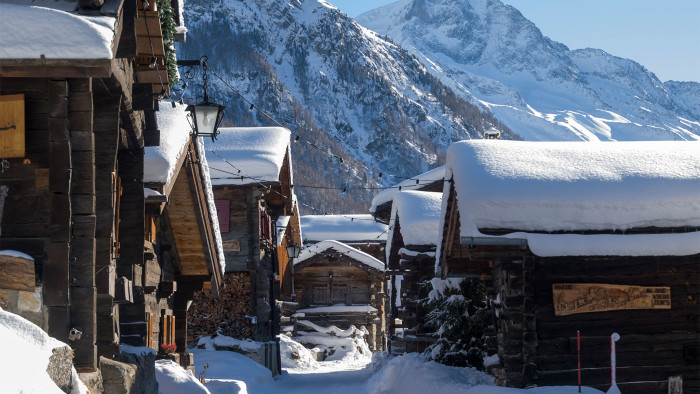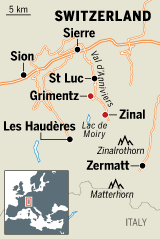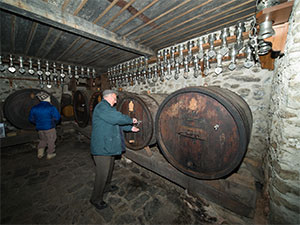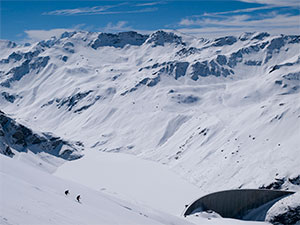Swiss skiing: Grimentz and Zinal

Simply sign up to the Life & Arts myFT Digest -- delivered directly to your inbox.
In a vaulted cellar in the small Swiss village of Grimentz, we are drinking wine straight from a wooden barrel. It’s not some new après-ski gimmick – in fact the barrel is marked 1762 and the tradition began long before that. This is vin du glacier, a speciality of the village: instead of being bottled, each year’s wine is poured into the existing barrels, where it mixes with what’s left of far older vintages.
In fact, the sweet, slightly sherryish wine we are trying is probably only 60 years old, says the man from the tourist office apologetically. He had meant to take us to try some far older stuff at the Bourgeoisie, a chalet built in 1550 to host meetings of the council made up of the village’s ruling families. Unfortunately it was busy, in use by the same body, who still hold sway in the village. Not much changes around here.
Even by Swiss standards, Grimentz is incredibly pretty and incredibly old. The larch chalets are turned black by years in the sun; the oldest was built in the 12th century. They crowd together, eaves almost touching, the narrow lanes between them protected from the worst of the wind and cold. In the heart of the village, close to what was the communal bread oven, you can imagine yourself in a Sherpa village in Nepal.
Grimentz sits at 1,570m on the flank of Val d’Anniviers – a sleepy valley that runs south off the main Rhône valley. It’s only 110km from the centre of Geneva and yet, until the 1950s, people in the Val d’Anniviers were still nomadic, moving with their animals up to the high pastures in summer, then back down the valley towards the Rhône in winter.
London’s Royal Festival Hall and the UN building in New York were both completed and in use before Zinal, the village at the far end of the valley, was reached by an asphalt road (1955). One person I meet tells me about the woman who had the area’s first “mixed marriage” around the same time, going on to explain that by this they mean not racially mixed, but with someone from outside the valley.

This winter though, change is coming. A new SFr28.6m (£19.5m), 3.5km-long cable car – the third longest in the country – is due to open on December 21, connecting Grimentz’s ski area with Zinal’s. Small resorts have struggled to stay profitable in recent years – nearby Super St Bernard has closed indefinitely – and “link-ups” are increasingly being seen as a way to stay competitive alongside the bigger players. This winter alone sees two other new links in Switzerland (between Bruson and Verbier, and Arosa and Lenzerheide). Grimentz and Zinal’s now-merged ski lift operating companies talk of attaining the “critical mass” needed to guarantee their long-term future: the new combined total of 120km of pistes (with another 100km in the valley accessible by bus) should promote them, if not quite into the premier league of resorts, then at least from obscurity into the mainstream.
In fact, the two villages have been quietly gaining a reputation among ski devotees for several years now, a byproduct of the revolution under way in the sport. New wider, specially shaped skis mean off-piste skiing is something anyone can do, rather than being reserved for a tiny hardcore. In turn, that hardcore has begun an obsessional search for new places with deep powder but without the crowds that can strip a mountain of powder within hours of a storm. Where once ski-nuts flocked to the same handful of celebrated resorts, there’s now a diaspora.
My first couple of nights in the valley are spent with Eric and Penny Kendall, who, as ski writers and photographers, spent a decade visiting 300 resorts on four continents. A guide from Andermatt – a resort in central Switzerland that is itself known for empty slopes – told them that when he had a day off and wanted peace and powder, he came here. The Kendalls followed the tip and never left, setting up a company running Edelweiss, a catered chalet for up to 12, and letting self-catering properties in Zinal.
Edelweiss is part boutique hotel, part ski lodge. The entrance hall is decorated with seven sets of mounted chamois horns, an armchair swathed in sheepskin, and a chandelier – but there are also climbing skins hanging up to dry. At dinner, conversation turns around snow conditions and off-piste routes; the wine glasses and plates of Gruyère and fennel tart are shuffled aside as maps are spread out.

In the morning I meet an old friend and we head out to explore Zinal’s slopes. As founder of Mountain Tracks, one the UK’s leading guiding companies, Nick Parks has for years led a peripatetic life among the world’s major ranges. Last winter, though, he decided to settle in one spot for most of the season, and chose Zinal. Like the Kendalls, he found it hard to leave: this winter he’s launching a new company here, Grimentz-Zinal Backcountry Adventures.
We take the lifts up to the Arête de Sorebois, at 2,896m, pausing to gawp at the Imperial Crown – the ring of five 4,000m peaks that tower above Zinal. Knowing that just beyond them is Zermatt, the internationally famous resort with almost 30,000 tourist beds, makes what happens next all the better. Turning in the other direction, we begin one of the area’s many classic off-piste routes, down to Lac de Moiry. It’s easy skiing – gentle, wide open slopes, covered in several feet of flattering fresh snow – yet we have it entirely to ourselves.
We reach the dam and start the 20-minute pole and slide across it, occasionally pausing to peer over the edge, flirting with the onset of vertigo. At the far side, we watch a family of chamois clattering away up the rocks, then continue our descent, through snow-covered pastures and down frozen footpaths into Grimentz.
That night I meet my second host, Will Herrington, whose story, by now, sounds rather familiar. A former managing director of upmarket ski operator Powder Byrne, he had spent his working life in Europe’s glitziest resorts. Then a guide in Grindelwald tipped him off about Grimentz and he came for a week’s holiday, loving the fact that he didn’t hear another British voice. He decided to have a year off here, and never left.
Now Herrington rents and sells luxury chalets, of which there are a growing number in Grimentz. I stay at Chalet Dragon, a newly built version of the village’s ancient chalets, combining cosy wooden rooms with modern bathrooms, an airy open plan living area and high-speed WiFi.

The icing on the cake is that Grimentz is one of only a few resorts in Switzerland where you can heliski straight from the village. As we sit drinking coffee outside the peaceful Hotel Cristal, this seems hard to believe. But eventually we hear the faintest of buzzes, which slowly grows until the roaring machine is sitting in the car park in front of us, rotor blades urgently scything the air. It whisks us off, above the chalet roofs and back over the Moiry dam, dropping us just below the 3,796m summit of the Pigne d’Arolla. It’s an extravagance of course, but here you can pay for a single lift (about £200) rather than committing to a full week (and several thousand pounds) as is the norm in Canada. The run down, through a glacial wilderness sparkling in the sun, takes us all afternoon.
Of course the fear, as with all such places, is that an influx of visitors will destroy the very character they seek. Already some locals fret that Grimentz might “do a Nendaz”, a reference to another Valais resort that has seen rapid changes at the hands of property developers. There are plans for a major new hotel beside the pistes in Grimentz, to be run as the first European property in the Six Senses chain, better known for Asian beach resorts. Foundations have been dug but no opening date has been announced.
Purists moan that, as is the case with many “link-up” projects, the expensive new lift doesn’t actually open a single kilometre of new piste, it just makes it easier for more people to access what’s already there. The hope is that while the lift will bolster local economies and attract families alongside powderhounds, there isn’t yet the volume of tourist beds to tempt in the mass-market tour operators, and the narrow, windy road up from Sierre remains a deterrent. Property prices are rising but, on balance, it seems visitors are unlikely to find a sudden explosion of champagne bars, Michelin stars and blacked-out 4x4s.
For now Grimentz has just one nightclub and one late-night bar. In Zinal, the big attraction is still the famous “fighting cows”, which lock horns during springtime festivals and spend the winter grazing in paddocks in the village centre. Wandering along the main street, I spot some graffiti – names scratched into the wood of a chalet wall. Closer inspection shows this isn’t a harbinger of impending social upheaval. Beside the names is the date they were written: 1876.
——————————————-
Details
Tom Robbins was a guest of Rental Prestige (rentalprestige.com), Ski Zinal (skizinal.com) and Swiss (swiss.com).
A week’s rental of Chalet Dragon, which sleeps up to six, costs from SFr3,456 (£2,352); a week at Ski Zinal’s Chalet Edelweiss costs from SFr1,040 (£708) per person; Grimentz-Zinal Backcountry Adventures (backcountryadventures.co.uk) has five-day courses from £545.
Swiss has up to 10 flights per day from London to Geneva, from £123 including ski carriage. A heli-lift (helialps.ch) from Grimentz to the Pigne d’Arolla costs SFr300 (£204) per person.
See also valdanniviers.ch
Comments